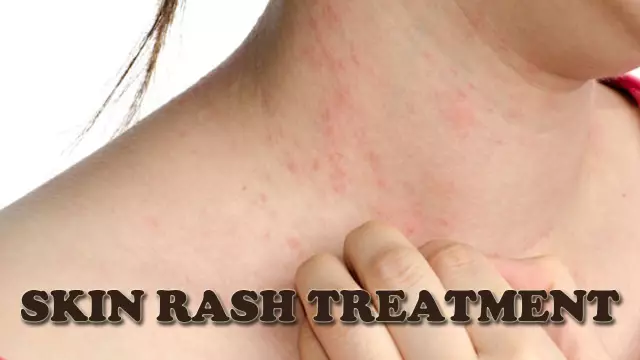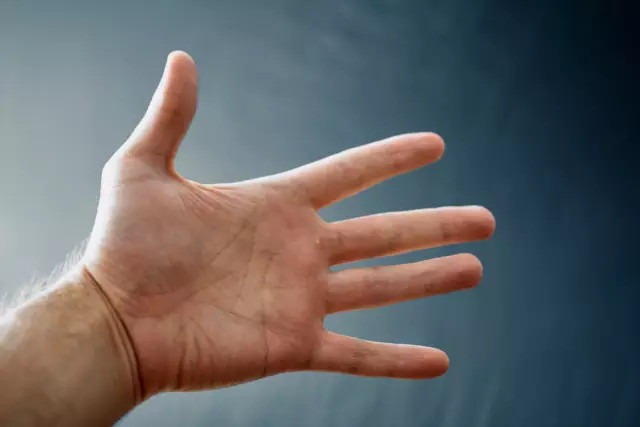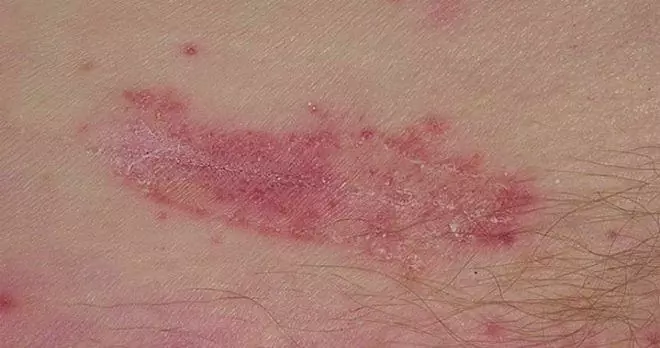- Author Rachel Wainwright [email protected].
- Public 2023-12-15 07:39.
- Last modified 2025-11-02 20:14.
Skin rash

Almost any dermatological disease is accompanied by the appearance of a skin rash. The skin is the largest human organ, and therefore, disturbances in the body's internal homeostasis, which, in essence, are diseases, will lead to its changes. Often these changes are manifested by a rash. Skin rashes are especially common in children.
Types of skin rashes
Skin rashes can be of various types. Rashes can be different from each other not only in appearance, but also in the speed of appearance, location, presence or absence of itching, etc.
There are the following main primary morphological elements of a skin rash:
1. Spot or makula. Located flush with unaltered skin. It appears in case of disorders of pigment metabolism, changes in blood vessels, with the introduction of artificial dyes under the skin (tattoos, etc.). The vascular spot is usually dark cherry to pale pink in color. Disappears when pressed. Restores color quickly. Such signs indicate an inflammatory nature. Spots resulting from increased permeability of the vessel wall are called hemorrhagic. The simplest example is a bruise. Hemorrhage into the skin in the form of dots or spots of various shapes and sizes, resulting from the destruction of skin vessels, is called hemorrhage (haemorrhagia). Petechiae (petechia) are the smallest or punctate hemorrhages. Many round hemorrhages 2-5 mm in diameter are described as hemorrhagic purpura (rigriga haetooggioe).
Hemorrhages of more than 5 mm of irregular shape are called ecchymosis (ecchymosis).
Hemorrhagic rash occurs with typhus, sepsis, hemorrhagic fevers. For meningococcemia, sepsis, stellate hemorrhagic skin rash is characteristic. Also, non-inflammatory vascular spots include nevus, telangiectasias, moles, vitiligo (depigmentation areas).
In size, a small-point skin rash is distinguished in the form of a spot of 5-10 mm and a large-spot 10-20 mm. Small-spotted is found in rubella, large-spotted can be a sign of allergies, measles.
When large spots merge, erythema is formed - erythema (lat.). It appears when the vessels of the papillary vascular plexus of the skin are dilated. Size over 20mm. A typical disease with erythema is erysipelas. 1st degree burns are also a type of erythema. All non-inflammatory spots are persistent, they do not disappear with pressure.
2. Blister or ultrica. It is a rather dense, round or oval element of skin rash that rises above unchanged skin. Has no cavity. Itching. Inclined to emerge quickly. Disappears without a trace. One of the most common manifestations of a blistering skin rash is a nettle mark. Blistering skin rashes are common in allergic reactions.
3. Papule, nodule - papula. It is a stripless, dense element of skin rash that rises above unchanged skin. The size ranges from 2 mm to 3 cm. Large papules are called plaques.
Depending on the size of the papules, there may be:
- miliary (with millet grain);
- lenticular papules (with lentils, peas);
- numular or coin-shaped, formed when flat large papules merge with each other during peripheral growth.
Very often in children, a skin rash in the form of papules is difficult to distinguish from roseolous.
Papules that arise in the epidermis due to limited thickening of cell layers are called epidermal flat warts. Also, papules can form in the dermis as a result of tumor development, inflammation, deposition of organic compounds (xanthomas, dermal papules with syphilis, etc.). There are also epidermal - dermal papules arising from two layers of skin at once. They are found with lichen planus, psoriasis, etc. The shape of the papules depends on the depth of occurrence and can be flat, polygonal, pointed, hemispherical.
The color of the papule depends on the cause of its occurrence. So, inflammatory papules are red. A gray-yellow color is characteristic of cholesterol papules.
This type of rash disappears without a trace.
4. A tubercle or tuberkulum is a dense, noncavity limited formation located above the surface of unchanged skin. Has a size of 1-10 mm. It is formed as a result of the accumulation of inflammatory infiltrate in the dermis. It differs from the papule in that a dense infiltrate is clearly defined on palpation of the tubercle. With the reverse development, the tubercle undergoes necrosis, often with ulceration and the formation of a scar or cicatricial atrophy of the skin. This type of skin rash occurs as a manifestation of leishmaniasis, skin lesions in tuberculosis, as well as tertiary and late congenital syphilis.
5. A node or nodus is a limited, noncavity, lump located deep in the skin. It rises above unchanged skin. The size of the nodes ranges from hazelnut to the size of a hen's egg. This type of skin rash is formed with the accumulation of cellular infiltrate in the dermis or subcutaneous tissue. The nodes of an inflammatory nature of a pasty consistency or soft, do not have clear boundaries, are prone to rapid disappearance and often have a reddish color of the skin above them. The nodes formed during specific inflammation are denser, prone to ulceration and decay. A scar often forms in their place.
6. A vesicle or vesicula is a cavity type of skin rash with a size of 1-5mm. Formed as a result of the detachment of the epidermis. May be filled with bloody, cloudy or clear contents. Shrinks into a transparent or brown crust. With spontaneous opening, erosion is formed with wetting. When an infection is attached, the vesicle turns into an abscess or pustule (pustula). A characteristic type of skin rash in children in the form of a bubble is a rash with chickenpox. Also, an example can be a rash with herpes simplex, enterovirus infection.
7. A bladder or bulla is a cavity element located in the upper layer of the epidermis and below it. Diameter up to 3-5 cm. The contents may be serous, bloody or purulent. May subside or break open with the formation of erosion. Leaves unstable pigmentation behind. It occurs in dermatosis herpetiformis (elements are located under the epidermis) and pemphigus vulgaris (vesicles inside the epidermis).
Secondary types of skin rash are elements that are formed from the primary, i.e. hyper- or depigmentation, scales, erosion, abrasions, ulcers, etc.
Skin rash treatment

Regardless of whether the rash is a manifestation of a dermatological disease or not, the treatment of a skin rash can be divided into 2 types:
- Influencing the cause of skin rash, i.e. direct treatment of the underlying disease. If any rash appears, you need to see a specialist who will treat the skin rash.
- Often, a skin rash is accompanied by itching, elements can open up, fester. That is why, in addition to treating the disease itself, it is necessary to observe hygiene, treat the rash with certain drugs, in some cases, treat the skin prophylactically.
YouTube video related to the article:
The information is generalized and provided for informational purposes only. At the first sign of illness, see your doctor. Self-medication is hazardous to health!






